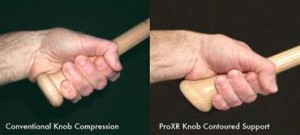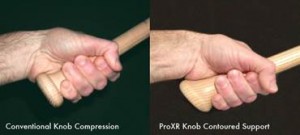Batter Up …With an Ergonomic Baseball Bat?
03/27/2014

By Bryan Picco, AEP
Well it's almost April and you know what that means… Major League Baseball season! If you are anything like me, this is the most eagerly anticipated time of year. Not only is baseball on TV most days of the week, but spring and summer recreational leagues kick off too (if this winter will ever end). For sports purists, baseball is the ultimate sport because the game has not changed that much over the last century – all you need is a bat, a ball, a glove, and some friends. For the most part, equipment design has stayed pretty constant over the years as well. Grady Phelan, the inventor of the Pro-XR baseball bat, is trying to change that using ergonomic principles.
Traditional baseball bats have a flared knob at the end of the handle, designed to prevent the bat from slipping out of the hands while swinging. This knob never really interfered with the batter’s hands that much because, traditionally, hitters were taught to “choke-up” on the bat (i.e. move the hands away from the handle knob) in order to create more bat speed. Newer players, however, position their hands against the knob (see below photo left) in order to lengthen the bat and extend their reach as much as possible. Do you see the problem (other than the awkward wrist postures)? This hand position against the knob creates increased soft tissue compression and impact stress at the base of the hand while swinging the bat – two physical stressors that accelerate injury development. As a result, baseball players have experienced an increase in hand tendon injuries and bone fractures. Professional players have gone to the extreme and actually removed the bones surgically to preserve their playing careers.
The Pro-XR baseball bat handle (photo right) is designed to reduce the soft tissue compression and impact on the hand by angling the knob away from the base of the hand, thereby leaving a smoother surface for the hand to rest against. The bat’s creator claims that the handle design reduces contact pressure by nearly 20%. This, in theory, should reduce hand injury risk. Ergonomists and baseball fans alike should watch closely to see if this bat design catches on amongst all levels of baseball and if injury occurrences reduce. Either way, the bat is a good attempt to apply ergonomic principles to America’s favorite pastime. Now if only we can fix those awkward wrist postures…







